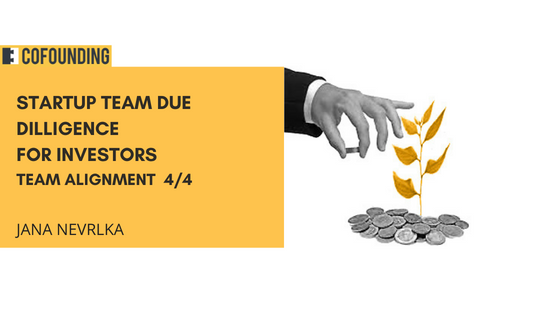Cofounding investors series 4.4
Startup cofounding team due diligence for investors
Series 4 / 4 Team alignment
In the cofounding investors series we look together on how to evaluate a startup cofounding team. How to identify any possible red flags and take care of the orange flags (mitigate the risks that do not present a deal breaker and you can take care of)
The last part of your due diligence is the soft side of the team - the team alignment and dynamics.
A) Are you aligned on the what, why and how?
This is the area that is the most difficult to evaluate. In the years I have worked with cofounding teams I have learned how careful one needs to be with its own judgments and assumptions. There are teams that I thought had it all, and 3 months later they would not talk to each other. There are teams that I wouldn't have bet a penny on - and 3 years later they are successfully growing and scaling their business. Looking back, the underlying (and sometimes not very visible) difference between the success and failure is - how well is the team aligned on the what, why and how.
If the founding team does not align with the what, how, and why, in almost every decision ahead they will struggle to reach an agreement. Irrespective of what legal voting powers may be in place, the business is not likely to get very far if cofounders want to go in different directions on every crossroad.
B) Did the team define (and test) their internal conflict resolution?
This question is very much from the area of ‘ prevention always beats corrections and fortune favours the prepared ones’.
How did the team define and test their internal conflict resolution is another well on information - if you listen well - that you get about the team. Did they already experience conflict? Did they prevent it? Or avoided it?
And how would they like to resolve future conflicts when they arise?
C) Does the team know their blindspot risk? Does the team know their friction risk?
This starts with the level of self-awareness of each team member. A level deeper, is the self-awareness of the team: what does the team perceive as their strong aspects? And what are the weaknesses (they are aware of)?
Very useful guide on team assessment was also summarised by an experienced angel investor, Cornelia Gut-Villa for SICTIC academy. Another useful resource to consider for this part of the team assessment is the leading brains startup team assessment which analyses the team dynamics and provides a useful summary of the team’s blindspot risk (where the founders are ‘too similar’) and friction risk (where the founders are very different).
Conclusion
Even though it would be very comfortable if it was otherwise, there is no way to eliminate all risks. However, a structured due diligence process enables you to spot many major risks early on - which either gives you the chance to mitigate them, or walk away.
The structured process does help. It gives the parties a checklist and tools to work through. The outcome is typically a more stable cofounding team, with existing risks (every team will have them) clearly identified and mitigated. One of the frequent and valuable side-effects of this process is also an increased trust - between the investors and founding team as well as between the founders - as everything was on the table and looked at.


